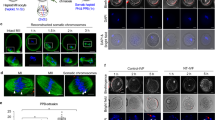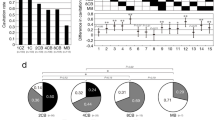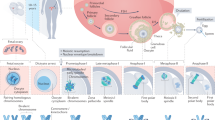Abstract
IN the early mouse embryo, spontaneous1 or experimentally induced2 triploidy is thought to arise by fertilization of an unreduced diploid egg by a haploid normal sperm. The possibility has not been wholly excluded that the extra set of chromosomes is derived instead from the male3—for example, double fertilization or diploid sperm—or after delayed fertilization4. In the rat and rabbit, Austin and Braden5 showed that experimentally delayed fertilization causes polyspermy; in the rat, chromosome counts at the first cleavage division showed that some dispermic eggs were triploid. It was suggested6 that some of the spontaneously triploid mouse embryos might have arisen in this way, and not by doubling of the maternal chromosomes.
This is a preview of subscription content, access via your institution
Access options
Subscribe to this journal
Receive 51 print issues and online access
$199.00 per year
only $3.90 per issue
Buy this article
- Purchase on Springer Link
- Instant access to full article PDF
Prices may be subject to local taxes which are calculated during checkout
Similar content being viewed by others
References
Beatty, R. A., and Fischberg, M., J. Genetics, 50 345 (1951).
Fischberg, M., and Beatty, R. A., J. Genetics, 50, 455 (1951).
Fischberg, M., and Beatty, R. A., Evolution, 6, 316 (1952).
Beatty, R. A., Anim. Breed. Abstr., 19, 283 (1951).
Austin, C. R., and Braden, A. W. H., Aust. J. Biol. Sci., 6, 674 (1953).
Austin, C. R., and Braden, A. W. H., Nature, 172, 82 (1953).
Runner, M. N., and Gates, A. H., Nature [174, 222 (1954)].
Runner, M. N., and Palm, J., J. Exp. Zool., 124, 303 (1953).
Author information
Authors and Affiliations
Rights and permissions
About this article
Cite this article
GATES, A., BEATTY, R. Independence of Delayed Fertilization and Spontaneous Triploidy in Mouse Embryos. Nature 174, 356–357 (1954). https://doi.org/10.1038/174356a0
Issue Date:
DOI: https://doi.org/10.1038/174356a0
Comments
By submitting a comment you agree to abide by our Terms and Community Guidelines. If you find something abusive or that does not comply with our terms or guidelines please flag it as inappropriate.



